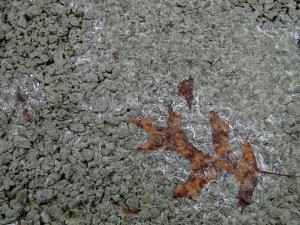Tom Ballestero and Rob Roseen, University of New Hampshire Stormwater Center
 Due to the need for improved stormwater management, the application of porous pavements is increasing dramatically in northern areas with cold climates. Yet, there are persistent misconceptions about these systems, in particular with regard to cold climate performance. Permeable pavement infiltration is not negatively affected by freezing; this pavement remains porous and does not become an impermeable ice block. Furthermore, permeable pavement requires less deicing throughout the winter season, and is more resistant to frost heave than standard pavement.
Due to the need for improved stormwater management, the application of porous pavements is increasing dramatically in northern areas with cold climates. Yet, there are persistent misconceptions about these systems, in particular with regard to cold climate performance. Permeable pavement infiltration is not negatively affected by freezing; this pavement remains porous and does not become an impermeable ice block. Furthermore, permeable pavement requires less deicing throughout the winter season, and is more resistant to frost heave than standard pavement.
In cold climates, surface cracks that allow infiltration into the subbase are a death knell for standard pavements. These pavements are designed to prevent moisture in the subsurface, which becomes increasingly difficult as pavements age, particularly with pavements that experience frost heaves.
However, porous pavements are built to drain, allowing water to pass through the surface to layers below. In addition, stone at the base of porous pavement systems breaks any capillary connection to groundwater. These design elements make porous pavement more resistant to freezing and frost heave.
Despite their infiltration capabilities, salt, and possibly sand, application is necessary irrespective of the pavement type. However, porous pavements are one of the very few salt reduction strategies for cold climates. As salt melts ice, the resulting liquid infiltrates into the porous pavement system. Porous pavement, therefore, may require more salt during the first applications, but much of the salt applied remains on the pavement days afterward, reducing the salt required for winter maintenance over the season.
Furthermore, when snow stockpiles melt and refreeze on a standard pavement, black ice forms and requires an additional application of deicer. On porous pavements, no standing water occurs, and thus — in areas with good solar exposure — plowing at the time of snowfall is sufficient for winter maintenance, resulting in a virtual elimination of deicer application.
Reducing the amount of deicer used can decrease winter maintenance costs and reduce stormwater laden with road salt chlorides, which are toxic to aquatic life.
However, not all permeable pavements perform the same in winter conditions. Darker surfaces with greater solar exposure tend to require less winter maintenance than light colored surfaces. Concrete porous pavement systems have demonstrated poor performance during winter salt application, resulting in weakening and spalling of the surface. They also appear to require a much longer curing time prior to deicing.














Wow, I had no idea that the reason that black ice formed was because of snow stockpiles melting and then refreezing. I only recently moved to a place where it snows, after living in California my whole life, so I had no idea that that is how black ice forms. I will be sure to research more about what I should do to protect and maintain pavement in cold climates. http://arrowblacktop.com/services.html